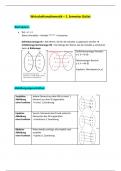Summary
Wirtschaftsmathematik - Vollständige Zusammenfassung
- Course
- Institution
Hierbei handelt es sich um eine ausführliche Zusammenfassung des Kurses "Wirtschaftsmathematik" (1. Semester, BWL, HBRS) - inklusive Formeln und Rechenbeispielen. Inhalte: Wirtschaftsmathematik (Funktionen, Nullstellen, Extrema, Elastizitäten etc.) Lineare Algebra (Matrix, Lineare Gleichu...
[Show more]



